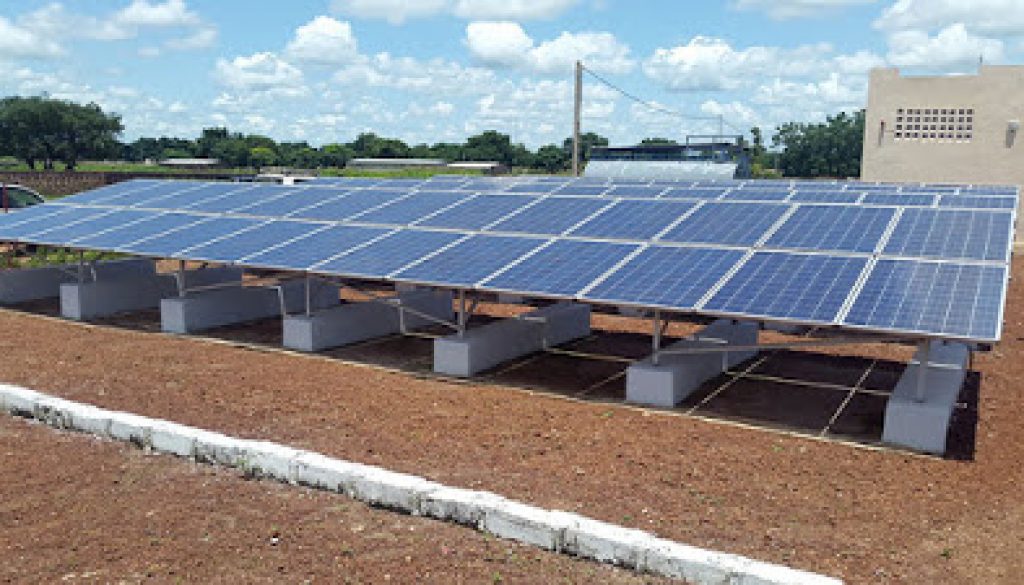Africa market for renewable energy
The United Nations Environment Program
(UNEP) says Africa could be one of the most promising markets for
renewable energy in the next decade due to its abundant solar.
(UNEP) says Africa could be one of the most promising markets for
renewable energy in the next decade due to its abundant solar.
It said that Africa also has abundant of
wind, biomass and other resources, which can be harnessed to drive
low-carbon economic growth, reduce the continent’s dependency on
environmentally-damaging fossil fuels.
wind, biomass and other resources, which can be harnessed to drive
low-carbon economic growth, reduce the continent’s dependency on
environmentally-damaging fossil fuels.
Africa, the world’s second largest
continent with 55 countries and over 1.2 billion people, is undergoing a
transformation and rapid development.
continent with 55 countries and over 1.2 billion people, is undergoing a
transformation and rapid development.
These countries are going fast and so are their energy demands.
It’s said that over the next 25 years, electricity needs will triple in southern Africa and quadruple in eastern Africa.
Until now, Africa has relied heavily on
electricity generated from fossil fuels, but there are a cleaner and
more sustainable ways to fuel this growth.
electricity generated from fossil fuels, but there are a cleaner and
more sustainable ways to fuel this growth.
Renewable electricity could displace up
to 20 billion kilowatts (KW) of fossil fuel generating capacity,
reducing total operating cost by one billion US dollars a year,
according to a report released by the International Renewable
Energy Agency.
to 20 billion kilowatts (KW) of fossil fuel generating capacity,
reducing total operating cost by one billion US dollars a year,
according to a report released by the International Renewable
Energy Agency.
Solar power
Green development and cooperation is one
of the ten major plans for China-Africa cooperation outlined by Chinese
President Xi Jinping during the China-Africa forum held in Johannesburg,
South Africa in December, 2015. Solar power,
one of the most prevalent clean energies on this continent, has seen
multiple collaboration between the two sides.
of the ten major plans for China-Africa cooperation outlined by Chinese
President Xi Jinping during the China-Africa forum held in Johannesburg,
South Africa in December, 2015. Solar power,
one of the most prevalent clean energies on this continent, has seen
multiple collaboration between the two sides.
Egypt, a country straddling Africa and
Asia, has over 90 per cent of its areas to be deserts. Dry and rain
less, it has a huge potential to develop solar energy. The country has
set a goal to make 20 per cent of electricity from
clean energy by 2022, with solar power as one integral part, to both
protect the environment and ease power shortage.
Asia, has over 90 per cent of its areas to be deserts. Dry and rain
less, it has a huge potential to develop solar energy. The country has
set a goal to make 20 per cent of electricity from
clean energy by 2022, with solar power as one integral part, to both
protect the environment and ease power shortage.
The country has partnered with China’s
clean energy company TBEA since this April for the construction of four
solar power stations in Egypt’s southern province of Aswan, as part of
the giant Benban Solar Plant.
clean energy company TBEA since this April for the construction of four
solar power stations in Egypt’s southern province of Aswan, as part of
the giant Benban Solar Plant.
The stations will generate 186-megawatts
(MW) of electricity and the plant is expected to generate up to
two-gigawatts (GW) of utility-scale solar capacity through 40 projects
after its completion by mid-2019. The project is TBEA’s
first in Africa, and the plant will be one of the largest in the world,
according to Xinhua News Agency.
(MW) of electricity and the plant is expected to generate up to
two-gigawatts (GW) of utility-scale solar capacity through 40 projects
after its completion by mid-2019. The project is TBEA’s
first in Africa, and the plant will be one of the largest in the world,
according to Xinhua News Agency.
“We’ll never be afraid to go out at
night,” said citizens of Bangui, capital of Central African Republic,
after the completion of a solar energy project supported by China in the
city in June, 2016. The project installed 200 solar-powered
street lamps for its public facilities and main roads.
night,” said citizens of Bangui, capital of Central African Republic,
after the completion of a solar energy project supported by China in the
city in June, 2016. The project installed 200 solar-powered
street lamps for its public facilities and main roads.
The project “effectively relieve Bangui’s
problems of energy shortage and poor lighting, and greatly improved the
night safety in the city,” said Jacques Medard Mboliaedas, minister of
Energy and Water, praising it a “popular
and well-received” livelihood project.
problems of energy shortage and poor lighting, and greatly improved the
night safety in the city,” said Jacques Medard Mboliaedas, minister of
Energy and Water, praising it a “popular
and well-received” livelihood project.
Other African countries, Kenya, Zambia,
Ghana, to name a few, are also cooperating with China to better realize
the United Nations’ 2030 Agenda for Sustainable Development.
Ghana, to name a few, are also cooperating with China to better realize
the United Nations’ 2030 Agenda for Sustainable Development.
Wind energy
Wind is a typical clean source of
renewable energy since it produces no air or water pollution. This
nature’s gift can successfully used for generating electricity in many
parts of Africa. In 2009, HydroChina and CGC Overseas
Construction Group (CGCOC), two Chinese-based companies signed an
Engineering, Procurement and Construction, short for EPC, contract with
Ethiopian Electric Power Corp. to develop a 51-MW wind farm at Adama. It
was the first Chinese overseas EPC project in
clean energy.
renewable energy since it produces no air or water pollution. This
nature’s gift can successfully used for generating electricity in many
parts of Africa. In 2009, HydroChina and CGC Overseas
Construction Group (CGCOC), two Chinese-based companies signed an
Engineering, Procurement and Construction, short for EPC, contract with
Ethiopian Electric Power Corp. to develop a 51-MW wind farm at Adama. It
was the first Chinese overseas EPC project in
clean energy.
In the first stage, China, along with
Ethiopia, has completed a project by constructing a wind farm with over a
100, 70-meter-tall turbines that have a total electricity generation
capacity of 153-MW.
Ethiopia, has completed a project by constructing a wind farm with over a
100, 70-meter-tall turbines that have a total electricity generation
capacity of 153-MW.
“China has worked with Ethiopia to train
engineers, technicians, experts, so when Chinese firms invest in
Ethiopia they can employ skilled Ethiopians and when Chinese companies
finish projects, there’s a trained Ethiopian workforce
that can take over and manage the projects,” according to Tan Jian,
Chinese Ambassador to Ethiopia.
engineers, technicians, experts, so when Chinese firms invest in
Ethiopia they can employ skilled Ethiopians and when Chinese companies
finish projects, there’s a trained Ethiopian workforce
that can take over and manage the projects,” according to Tan Jian,
Chinese Ambassador to Ethiopia.
Bio-energy
Bio-energy, derived from the organic
material that includes crop waste, forest residues, food waste, and wood
waste, is another form of renewable energy that can produce
electricity, heat, transportation fuels.
material that includes crop waste, forest residues, food waste, and wood
waste, is another form of renewable energy that can produce
electricity, heat, transportation fuels.
Wide access to this affordable,
sustainable energy is and will be increasingly crucial to the growth and
development across Africa, where most of the people count on the land
to survive.
sustainable energy is and will be increasingly crucial to the growth and
development across Africa, where most of the people count on the land
to survive.
By partnering with the local government, a
huge biomass power plant, financed by Chinese company Shenyang Lan Sa
Trading Co Ltd, in Mansoa, central Guinea-Bissau, west Africa has gone
into initial construction last year.
huge biomass power plant, financed by Chinese company Shenyang Lan Sa
Trading Co Ltd, in Mansoa, central Guinea-Bissau, west Africa has gone
into initial construction last year.
The project, design to supply power to
the cities of Bissau and Mansoa, boasts a 30-MW production capacity,
which will be powered by agricultural waste, such as rice hulls, corn
and other grains, according to the Macauhub, a Macau-based
media.
the cities of Bissau and Mansoa, boasts a 30-MW production capacity,
which will be powered by agricultural waste, such as rice hulls, corn
and other grains, according to the Macauhub, a Macau-based
media.
Successful cooperation stories between China and African countries are blooming across the continent.
The interim secretariat of China-Africa
environmental cooperation center was inaugurated in Nairobi, Kenya, on
August 17, which aims to promote the transfer of green technologies
between China and Africa, share green development
experiences, and provide a bridge for bilateral exchanges.
environmental cooperation center was inaugurated in Nairobi, Kenya, on
August 17, which aims to promote the transfer of green technologies
between China and Africa, share green development
experiences, and provide a bridge for bilateral exchanges.
For the efforts China has made along the
way, the former UN Secretary-General Ban Ki-moon said that “these
projects are good examples of how organizations can form partnerships
through South-South cooperation. They are the positive
actions taken by China and African countries to realize the 2030 Agenda
for Sustainable Development.”
way, the former UN Secretary-General Ban Ki-moon said that “these
projects are good examples of how organizations can form partnerships
through South-South cooperation. They are the positive
actions taken by China and African countries to realize the 2030 Agenda
for Sustainable Development.”




